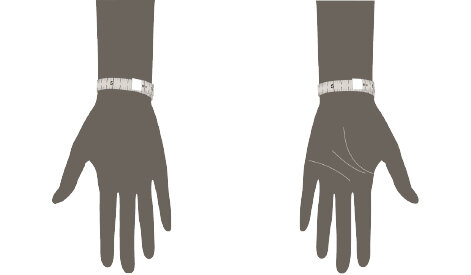Sizing & Jewelry Care
Ring Sizing
Please have a professional jeweler size your fingers. Do not guess. Each finger is different, and size is affected by weather, temperature, diet and/or hormones. Lucky for you, we are professional jewelers and can size your finger at our studio. If you’re unable to visit us or another jeweler, we do sell personal ring sizers here so you can measure at home. Please note that the width of the band will affect the fit, and wide band rings (3/8” or more) fit much tighter than traditional rings, so please size up at least a 1/2 size.
Bracelet Sizing
After working with many customers, we can safely say that the “perfect” bracelet fit is a relative term. Two people with identical wrists oftentimes prefer different size bracelets or bangles. It’s not wrong, just merely an expression of each person’s taste.
The easiest way to determine your ideal fit is to find a bracelet you already own and measure its diameter (across the inside) or its length and compare it to our products. If that’s not possible, use our instructions below or message us at hello@morrisonmae.com for guidance.
Bangles — Bangle size is determined by the size of your hand, not your wrist. To determine your bangle size, simply tuck your thumb into the palm of your hand (as if about to put on a bangle) and using measuring tape, measure your hand all the way around the set of knuckles closest to your wrist, from knuckle to knuckle and add at least 1/4-1/2” to that measurement for comfort. Compare that measurement to the chart below. If you are in between, we recommend sizing up to ensure they fit. Our bangles are individually handmade so the circumference will fall within the range of each size.
Guide for Bangle bracelet sizing
Bangle Measurement chart
Cuffs & Chain/Link Style Bracelets — These bracelets are sized to fit more snugly on the wrist area. Use a measuring tape to wrap around your wrist as tight or loose as you like. Match this measurement to the correlating row on the size chart below. For example, a wrist measuring just over six inches would correspond to a woman’s medium.
Our cuffs are crafted for maximum style and comfort, and we allow for extra room on your wrist. However, if you are on the cusp between two sizes, select the smaller size for a tighter fit, or larger size for a looser fit, depending on your preference. We design our cuff bracelets to fit snugly with a one inch opening at the back. These are adjustable within a small range.
Generally speaking a 6” cuff will fit the average female wrist or the smaller than average male wrist. Our stock pieces are made to an average size. if you require something smaller or larger please inquire, sometimes slight changes can be made.
Cuff & Link/Chain style bracelet measurement chart
Guide for Cuff & Link bracelet sizing
Necklace Sizing
Standard necklace lengths are 16", 18", 20", 24", 30" and 36". The majority of our necklaces are 18" and will rest just below your clavicle. Please read descriptions carefully so you know what you are getting. If you would prefer a shorter or longer length please send us a message before you order and we’ll let you know if it’s possible.
We solder all of our connections closed to ensure long term wear, so altering chain length may incur an additional small repair charge.
We do sell this 2” necklace extender for a more affordable DIY solution in order to add a small amount of length.
Caring For Your New Jewelry
To delay the onset of tarnish, always store your jewelry in a closed jewelry box or sealed bag. Tarnish is unfortunately unavoidable and will happen in time to any metal if left exposed to the air.
Keep your jewelry clean and shiny by polishing it from time to time with an impregnated cloth like this one to remove any tarnish. Or use a clean toothbrush with mild soap and water to remove dirt and oils. A liquid cleaner specific to your metal can also work, but take care—do not use liquid cleaners on pieces with set stones or oxidized (blackened) areas as it can either damage the stone or remove the blackening. Avoid any abrasives, such as baking soda or toothpaste, on polished metal as these will actually scratch the surface making it dull in appearance.
Jewelry and gemstones are delicate things and will break and scratch if not stored or treated properly. Rings and bracelets tend to take the biggest beating, so please do not wear your jewelry during heavy activities such as working out, gardening, hiking, construction, house cleaning and swimming (avoid chlorine or saltwater at all costs). Exposure to chemicals and harsh conditions can reduce the life of your piece and may damage it beyond repair.




